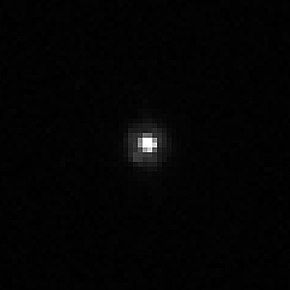 2002 WC19 and its satellite imaged by the Hubble Space Telescope in 2007 | |
| Discovery | |
|---|---|
| Discovered by | Palomar Observatory |
| Discovery date | 16 November 2002 |
| Designations | |
| (119979) 2002 WC19 | |
| Twotino[1][2] binary | |
| Orbital characteristics[3] | |
| Epoch 13 January 2016 (JD 2457400.5) | |
| Uncertainty parameter 3 | |
| Observation arc | 3978 days (10.89 yr) |
| Aphelion | 60.732 AU (9.0854 Tm) |
| Perihelion | 35.289 AU (5.2792 Tm) |
| 48.010 AU (7.1822 Tm) | |
| Eccentricity | 0.26498 |
| 332.67 yr (121,507 d) | |
| 316.02° | |
| 0° 0m 10.666s / day | |
| Inclination | 9.1746° |
| 109.7547° | |
| ≈ 5 November 2056[4] ±3 days | |
| 44.356° | |
| Known satellites | 1 (81 km)[5] |
| Earth MOID | 34.3056 AU (5.13204 Tm) |
| Jupiter MOID | 29.9229 AU (4.47640 Tm) |
| Physical characteristics | |
| Dimensions | 338 km[5] |
| Mass | (8.13±1.0)×1019 kg (prograde) or (7.263±0.87)×1019 kg (retrograde) [6] |
Mean density | 1.97 g/cm3[5] |
| 0.07 (expected from theory)[7] | |
| 4.9 | |
(119979) 2002 WC19 (provisional designation 2002 WC19) is a twotino, that is, a planetoid in a 1:2 orbital resonance with Neptune. It was discovered on November 16, 2002 at the Palomar Observatory. If its derived diameter is correct it would have a higher density than Pluto, which is unusual as it appears to be much smaller than the expected size at which a Kuiper belt object usually becomes solid.
Knowing how many twotinos there are may reveal whether Neptune took roughly 1 million or 10 million years to migrate about 7 AU from its birth location.[8]
- ^ Cite error: The named reference
Buiewas invoked but never defined (see the help page). - ^ Cite error: The named reference
MPEC 2009-C70was invoked but never defined (see the help page). - ^ Cite error: The named reference
jpldatawas invoked but never defined (see the help page). - ^ JPL Horizons Observer Location: @sun (Perihelion occurs when deldot changes from negative to positive. Uncertainty in time of perihelion is 3-sigma.)
- ^ a b c Cite error: The named reference
johnston119979was invoked but never defined (see the help page). - ^ Cite error: The named reference
Grundy2019was invoked but never defined (see the help page). - ^ Cite error: The named reference
brown-dplistwas invoked but never defined (see the help page). - ^ Cite error: The named reference
on-the-fringewas invoked but never defined (see the help page).